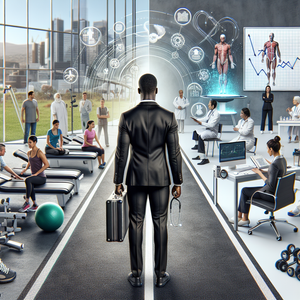The Future of Healing Hands: How AI and Robotics Will Complement Human Touch in Physical Therapy

At its core, physical therapy is a deeply human experience. It is not simply about restoring movement or alleviating pain; it is about forging meaningful relationships with patients during some of the most vulnerable moments of their lives. PTAs often serve as more than just clinicians—they are motivators, confidants, and emotional support systems. Scientific research underscores the importance of these human elements in physical therapy. For instance, a study in the Journal of Orthopaedic & Sports Physical Therapy revealed that patients who reported stronger therapeutic alliances with their physical therapists achieved better recovery outcomes. This highlights the profound role of trust, rapport, and emotional connection in healing. The warmth of a comforting touch, the encouragement offered during a challenging session, or the ability to intuitively adapt a therapy plan based on a patient’s nonverbal cues cannot be replicated by machines. These human qualities form the foundation of physical therapy, enabling PTAs to address not just the physical but also the emotional and psychological needs of their patients.
The Role of AI and Robotics in Physical Therapy
While the human touch remains irreplaceable, AI and robotics bring unprecedented potential to enhance the effectiveness of physical therapy. These technologies are not designed to replace PTAs but rather to equip them with tools that can elevate the quality of care. AI excels at processing large volumes of data and identifying patterns that might be overlooked by humans. In physical therapy, AI algorithms can analyze patient data—such as medical histories, movement patterns, and imaging results—to assist PTAs in making accurate diagnoses and designing highly personalized treatment plans. Robotic devices are revolutionizing rehabilitation, providing precise and consistent assistance for patients recovering from severe injuries or conditions such as strokes or spinal cord injuries. Robotic exoskeletons, like those developed by Ekso Bionics, help patients perform repetitive movements with accuracy, promoting neuroplasticity and accelerating recovery. Virtual reality (VR) and telehealth technologies are opening new doors for accessible and engaging physical therapy. VR-based rehabilitation programs immerse patients in interactive environments that make therapy more enjoyable and effective. Telehealth platforms, on the other hand, enable PTAs to extend their reach to patients who may not have access to in-person care, providing guidance, tracking progress, and ensuring continuity of care.
The Balance Between Technology and Humanity
The integration of AI and robotics into physical therapy highlights the need for a balanced, hybrid approach. While technology can handle tasks requiring precision, efficiency, and data analysis, it lacks the emotional intelligence, adaptability, and compassion that define PTAs. Consider a stroke patient undergoing rehabilitation. A robotic exoskeleton might facilitate precise limb movements, but it is the PTA who recognizes when the patient feels discouraged, offers words of encouragement, or adjusts the session to match their emotional state. This synergy—where technology enhances physical capabilities and PTAs provide emotional and psychological support—is the future of physical therapy.
Preparing PTAs for the Future
To thrive in this evolving landscape, PTAs must embrace a mindset of lifelong learning and adaptability. Educational programs and professional development initiatives should focus on equipping PTAs with the skills needed to integrate AI and robotics into their practice. This includes training in data analysis, machine operation, and understanding the ethical implications of technology use in healthcare. At the same time, PTAs must continue to hone the qualities that set them apart from machines: empathy, communication, and the ability to build trust. By combining technical proficiency with emotional intelligence, PTAs can solidify their role as indispensable partners in the healing process.
The future of physical therapy is not a choice between technology and humanity—it is a fusion of the two. AI and robotics offer powerful tools to enhance the precision and efficiency of care, but they will never replace the human touch that defines the profession. For Physical Therapist Assistants, this represents an opportunity to evolve, leveraging technology to amplify their impact while continuing to provide the compassion and connection that patients need. In this new era, PTAs will remain at the heart of physical therapy, guiding patients toward recovery through a blend of innovation and humanity. The healing hands of PTAs, complemented by the power of AI and robotics, will ensure that physical therapy continues to be both effective and deeply personal. This harmonious integration of technology and human expertise is not just the future—it is the key to unlocking the full potential of physical therapy.
AI Integration Specialist in Healthcare
GE Healthcare, IBM Watson Health, and Philips
Responsibilities
Collaborate with healthcare teams to implement AI technologies, such as diagnostic tools or patient-monitoring systems.
Analyze clinical data to improve treatment workflows and optimize patient outcomes.
Train medical professionals, including physical therapists, to effectively use AI platforms in their practice.
Required Skills
Expertise in healthcare informatics, machine learning, and data analysis.
Strong understanding of clinical workflows and patient care protocols.
Communication skills to bridge the gap between technical teams and healthcare providers.
Rehabilitation Robotics Specialist
Ekso Bionics, ReWalk Robotics, and hospitals with advanced rehabilitation centers
Responsibilities
Design and operate robotic devices such as exoskeletons to assist in physical therapy and rehabilitation.
Customize robotic therapy programs to meet the specific needs of patients recovering from strokes, spinal cord injuries, or surgeries.
Monitor patient progress and adjust robotic settings to align with therapy goals.
Required Skills
Knowledge of biomechanics, robotics engineering, and physical therapy principles.
Hands-on experience with devices like Ekso Bionics or ReWalk Robotics.
Ability to troubleshoot and maintain robotic equipment.
Virtual Reality Rehabilitation Developer
MindMaze, Oculus (Meta), and innovative rehabilitation clinics
Responsibilities
Develop VR-based rehabilitation programs that simulate real-life tasks to improve patient mobility and coordination.
Work closely with therapists to design immersive experiences tailored to different conditions (e.g., stroke recovery, balance training).
Test and iterate VR systems, ensuring they meet both therapeutic and user-experience goals.
Required Skills
Proficiency in VR development platforms (Unity, Unreal Engine) and motion-tracking technologies.
Understanding of physical therapy and rehabilitation techniques.
Creativity to design engaging and effective therapeutic environments.
Telehealth Physical Therapy Coordinator
Teladoc Health, Amwell, and large healthcare systems offering telehealth services
Responsibilities
Manage and deliver physical therapy sessions remotely using telehealth platforms.
Assess patient progress via video consultations and wearable monitoring devices.
Develop personalized home exercise programs that patients can follow independently.
Required Skills
Licensure as a physical therapist or PTA, with experience in remote care delivery.
Familiarity with telehealth software and remote patient monitoring tools.
Strong communication and adaptability to address patient needs virtually.
Healthcare Data Analyst in Rehabilitation
Cerner, Epic Systems, and rehabilitation clinics with data-driven approaches
Responsibilities
Analyze patient data (e.g., range of motion, therapy outcomes) to identify trends and optimize treatment plans.
Develop predictive models to enhance rehabilitation strategies and track patient progress.
Work with therapists to integrate data insights into daily practice for better patient outcomes.
Required Skills
Proficiency in data analysis tools (Python, R, Tableau) and healthcare databases.
Familiarity with physical therapy metrics and outcomes measurement.
Analytical thinking to derive actionable insights from complex datasets.


